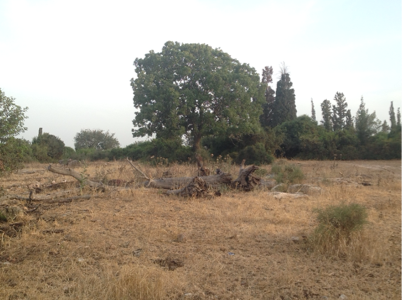Info
District: Haifa
Population 1948: 1450
Occupation date: 12/05/1948
Jewish settlements on village/town land before 1948: None
Jewish settlements on village/town land after 1948: Aviel
Background:
Al-Sindiyana Before 1948
At 29 km distance from Haifa, the village was situated on two small hills southeast of the foothills of Mount Carmel, on the edge of the area known as the bilad al-rawha' ('the country of fragrant vines'). Secondary roads linked al-Sindiyana to neighbouring villages as well as to the coastal highway. Its name means 'oak tree' in Arabic. The original inhabitants came from two neighbouring villages, Umm al-Fahm and 'Arraba, and founded the village over two centuries ago.
Al-Sindiyana had a boys' elementary school with an enrollment of 200 students in 1942/43. Its houses were made of masonry, and its numerous springs and wells provided water for both domestic use and irrigation. The villagers obtained their livelihood from agriculture and animal husbandry, growing mainly grain and vegetables, especially tomatoes. The archeological site of al-Khirba lay about 2 km south-west of al-Sindiyana. It is reported to contain building foundations, and pottery and tesserae have been seen on its surface.
Occupation, Depopulation, and Israeli Settlements
Al-Sindiyana was ethnically cleansed in 1948 by the Irgun (Etzel) and Lehi (Stern Gang) militias. Its residents were expelled, some of them were murdered, and the dozens of homes left abandoned were blown up. On May 13, 1948, HaMashkif, a newspaper owned by the Revisionist movement, wrote that 'the cleansing of the Efraim Mountains continues': 'As the soldiers approached, the village was rocked by heavy mortar fire, and wave after wave of foot soldiers attacked the enemy. This powerful attack broke the enemy’s resistance, prompting the flight of frightened Arabs toward the Triangle area.' The commander of one of the platoons, Moshe Nir (Wagner), who was known by his nome de guerre, Nachson, provided a testimony to the Irgun archives nine years after the expulsion: 'The platoon drew closer to Sindiyana and conquered the village without any loss of life on the attacker side. The platoon was not able to enter into battle with the enemy, since the Arabs fled and abandoned the village, aside from the mukhtar who remained in the village with his family and raised a white flag above his home.' According to Nir, in Sabbarin there was 'a great panic…and a massive fleeing of the residents. Then the armored vehicle began following those who fled while firing at them.'
It turns out, however, that not everybody fled. Nir continued: 'We built an enclosure where we put all the elderly, women, and children who were not able to flee… their numbers reached over 100. After a number of days… we sent them away with accompaniment in the direction of Umm al-Fahm, in order to ensure that they do not remain in the area or attempt to return to the villages.' Later on, Nir describes how during a search of the column of refugees, a pistol and a rifle were found. Seven men were detained and were asked who the weapons belonged to. After the soldiers carried out a 'field court martial', sentenced the seven to death, and thereafter executed them on the spot.
Another commander from one of the Irgun platoons involved in ethnically cleansing al-Sindiyana and Sabbarin was Amitai (his last name is not listed in the Irgun archives), who was known as 'Mike'. Amitai confirms Nir’s testimony, adding several details of his own: 'While the preparations for the operation were done clandestinely, when we arrived at Sindiyana it became clear (due to a small fortification) that a resident of Binyamina (suspected to be Leibovitch) convinced most of the village residents to surrender without gunfire.'
Amitai continues and describes a 'case of one man who looted and acted unkindly with the Arab women. That same soldier was put on trial and was recommended to be lashed, but that was never implemented.'
The settlement of Avi'el was established in 1949 on village lands southwest of the village site.
The Village Today
The site is fenced in with barbed wire. Scattered piles of stones, the debris of destroyed houses, are visible among thorns, cactuses and fig, olive, and palm trees. The surrounding lands are used by Israelis as a grazing area.
------------------------------
Sources: al-Khalidi, Walid (ed.). All that remains: the Palestinian villages occupied and depopulated by Israel in 1948. Washington DC: 1992.
Rotem, Noam. The ethnic cleansing of Sindiyana in +972. 14 Septembrie 2014.


